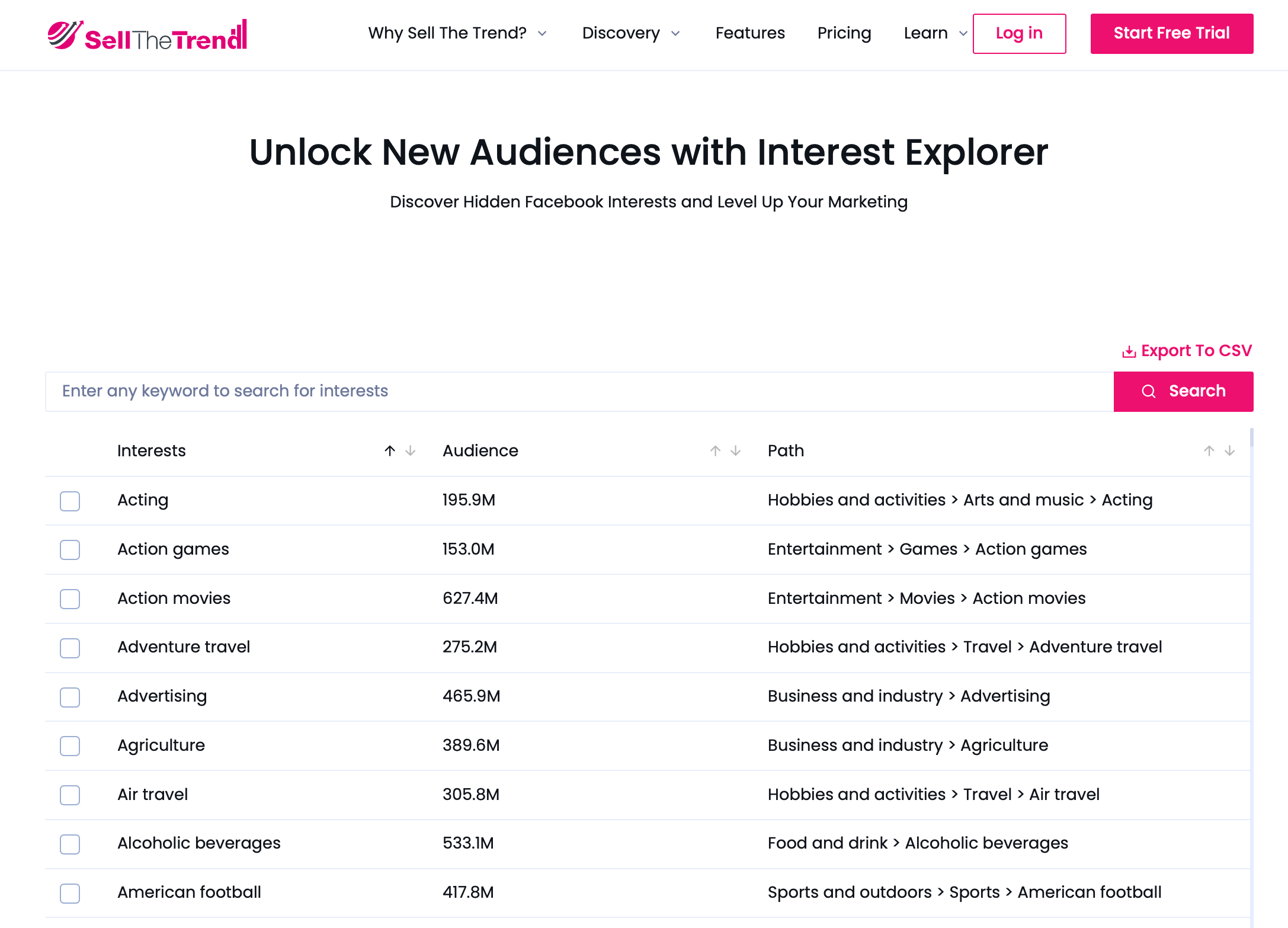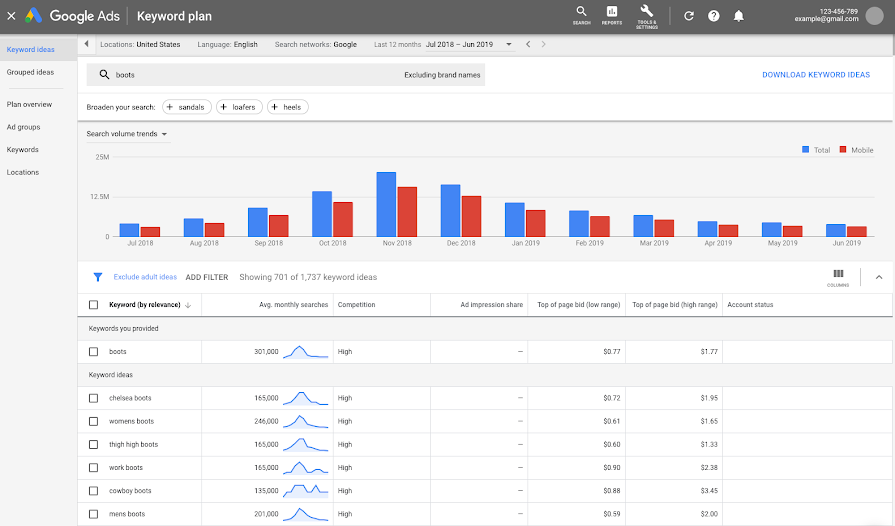How to Master Google Keyword Planner for Winning Product Ideas in 2025
Contents

Finding winning product ideas can feel like one of the hardest parts of the process, especially when it seems like every idea falls flat. We’ve all been there—choosing something we think is perfect, only to discover that no one wants it.
Here, you’ll discover simple and effective ways to use Google Keyword Planner to uncover product ideas that people are actively searching for. You’ll also understand why the right product makes all the difference and how to spot the ones that stand out.
By the end, you’ll feel confident and ready to find winning product ideas that truly work. Let’s get started.
Key Takeaways
- Google Keyword Planner is your go-to tool for finding winning product ideas by showing what people are actively searching for.
- Combining it with tools like Sell The Trend can help you uncover niche products and spot untapped opportunities.
- Look for keywords with high demand and low competition to find the best products to sell and boost your chances of success.
- Exploring related keywords and keeping an eye on trends will help you stay ahead and keep your dropshipping store relevant.
- Validating product demand with real data ensures you’re choosing items people want to buy.
Why Do We Even Need Google Keyword Planner?
When it comes to finding winning product ideas, guessing simply doesn’t work. One mistake many of us make is relying on what we think will sell rather than on what customers want.
The result? A store full of products that no one searches for or buys.
This is where Google Keyword Planner changes the game. It gives you real data—what people are actively searching for, how often they search, and even what’s trending. I’ve learned the hard way that data-driven decisions lead to success, while gut feelings often lead to failure. If you want to avoid wasting time and effort on products no one wants, this tool is a must
Another great tool to pair with Google Keyword Planner is Sell The Trend’s Interest Explorer.
This tool takes product research a step further by analyzing customer interests and trends across platforms like Facebook and Instagram. It’s designed to help you discover niche products that people are genuinely interested in—saving you from the frustration of picking items that don’t sell.

Here’s how to use it:
- Enter a keyword or niche idea, such as “home workout” or “kitchen gadgets,” to generate data on related products and trends.
- Look at how people are interacting with similar products on platforms like Facebook and Instagram. Metrics like likes, shares, and comments show customer interest.
- Identify products with growing demand or consistent interest over time. For example, you might notice a spike in interest for “compact air fryers” or “eco-friendly water bottles.”
- Use the insights to uncover unique product ideas or underserved markets that competitors might have missed.
- Pair the interest data with Google Keyword Planner to confirm that your product idea has both customer engagement and search demand.
Step-By-Step Guide To Master Google Keyword Planner For Winning Product Ideas

How do you master Google Keyword Planner to uncover winning product ideas?
In this section, I won’t just tell you how to use the tool—I’ll guide you step by step to ensure you’re using it effectively to find profitable dropshipping products.
There are 7 steps to mastering this process:
- Set your goals
- Enter broad product ideas
- Analyze keyword data
- Refine your keywords
- Explore related keywords
- Validate product demand
- Track trends over time
Let’s break each one down to help you build a solid foundation for a successful dropshipping business.
1. Set Your Goals
Before diving into product research, it’s crucial to set clear goals. Why? Because without a direction, you can end up wasting time chasing products that don’t fit your business strategy. Goals help you focus and ensure every product you consider serves a purpose in your journey to success.
What should your goals look like? That depends on your priorities and business model. Ask yourself: Are you targeting a specific audience, like eco-conscious buyers? Do you want trending products for quick sales, or evergreen items that sell all year round?
Here are a few examples of specific goals:
- Focus on products with low competition but growing demand.
- Target niches with repeat-purchase potential, like skincare or home essentials.
- Prioritize items with profit margins of at least 30%.
Your goals should also reflect what success means to you. For instance, if you’re aiming for high-ticket products, you’ll need to find items with proven demand and solid profit margins. If steady growth is your goal, focus on affordable products that drive consistent sales volume.
Setting goals is not just about what to sell but why you’re selling it. When you know your destination, tools like Google Keyword Planner or Sell The Trend can help you map the best route to get there. Don’t skip this step—it’s the foundation of finding winning products.
2. Enter Broad Product Ideas
Once you’ve set your goals, it’s time to start exploring product ideas. The first step? Keep it simple. Begin with broad product categories or keywords related to your niche. This helps you cast a wide net and uncover a variety of options to refine later.
What do broad ideas look like? Let’s say you’re interested in the fitness niche. Instead of searching for something specific like “adjustable dumbbells,” start with broader terms like “fitness equipment” or “home workout.” These initial keywords will help you discover trends and related products you might not have considered.
Here’s how to get started:
- Think of categories like “kitchen gadgets,” “outdoor gear,” or “pet supplies.”
- Use terms that describe problems people want to solve, like “back pain relief” or “organizing tools.”
- Look for inspiration in seasonal items, such as “summer essentials” or “holiday decor.”
Once you input these broad ideas into tools like Google Keyword Planner or Sell The Trend, you’ll receive a list of keywords, search volumes, and trends. Pay attention to the results that show steady interest or growing demand.
Starting broad allows you to explore multiple directions without getting stuck on one idea too soon. From here, you can begin narrowing your focus and identifying specific products that align with your goals.
3. Analyze Keyword Data
Now that you’ve entered your broad product ideas, it’s time to analyze the keyword data. This step turns raw information into actionable insights, helping you identify winning products backed by real demand.
Here’s what to focus on:
- Search Volume: Look for keywords with a high number of searches, as they indicate strong demand.
- Competition Level: Keywords with low-to-medium competition are ideal for finding products in less crowded markets.
- Trend Analysis: Check if the keyword’s interest is steady, increasing, or seasonal to gauge its long-term potential.
Let’s say your broad idea was “pet supplies.” Upon analyzing the keyword “dog grooming kit,” you notice it has a high search volume, moderate competition, and consistent interest throughout the year. This makes it a solid contender for further research.
Tools like Google Keyword Planner simplify this process by providing detailed metrics and graphs for each keyword. Use filters to refine your data based on location, language, or device usage, ensuring the results align with your target audience.
By analyzing keyword data, you move from vague ideas to specific, data-driven product possibilities. This step ensures you focus your efforts on products that people are actively searching for, increasing your chances of success. Always let the data guide your decisions—it’s the difference between guessing and knowing.
4. Refine Your Keywords
Once you’ve analyzed your keyword data, it’s time to narrow down your focus. Refining your keywords helps you target the most promising product ideas and avoid wasting time on irrelevant or overly competitive ones.
Why is this important?
Not every keyword with high search volume will work for your goals. Some may have intense competition, while others might not align with your niche. For example, if you started with “kitchen tools,” you might find keywords like “silicone baking mats” or “compact vegetable choppers” that are more specific and actionable.
How do you refine your keywords?
- Focus on long-tail keywords, like “eco-friendly yoga mat” instead of just “yoga mat.”
- Use filters in tools like Google Keyword Planner to sort keywords by search volume, competition, or geographic relevance.
- Exclude irrelevant keywords or ones with extremely high competition.
Refining your keywords isn’t just about shrinking your list—it’s about zeroing in on the best opportunities. By the end of this step, you’ll have a clear set of keywords that align with your goals and target audience, setting you up to discover winning product ideas.
5. Explore Related Keywords
After refining your keywords, exploring related keywords in Google Keyword Planner is the next step. This process helps uncover variations or complementary ideas that can lead to untapped product opportunities. Often, related keywords highlight how customers search for similar products, giving you valuable insights into their preferences and needs.
Why explore related keywords? It’s simple—your initial keywords might only scratch the surface. For example, if your keyword is “yoga mat,” related terms like “non-slip yoga mat,” “eco-friendly yoga mat,” or “travel yoga mat” could reveal niche markets with high demand. These variations help you better align with what people are actively searching for.
Here’s how to find related keywords using Google Keyword Planner:
- Look at the “Keyword Ideas” section after entering your primary keyword. It lists related terms along with their search volumes, competition levels, and trends.
- Identify terms that fit your niche and have steady or growing search interest.
- Filter out irrelevant or overly competitive keywords to focus on actionable opportunities.
For example, if “yoga mat” shows related terms like “foldable yoga mat” or “kids yoga mat,” you can explore those niches further to evaluate their potential.
Exploring related keywords ensures you don’t miss out on profitable ideas and helps you refine your strategy based on real search behavior. This step can uncover hidden gems that give you a competitive edge in finding winning product ideas
6. Validate Product Demand
After identifying promising keywords, the next crucial step is validating product demand. This ensures you’re focusing on products people actively want and are willing to buy, saving you time and effort on ideas that won’t sell.
Why is validation important?
Because high search volume doesn’t always translate into real demand. For instance, a keyword like “luxury dog collars” might have a high search count, but that doesn’t mean customers are purchasing them at the same rate. Validation bridges the gap between interest and actual sales potential.
How do you validate product demand with Google Keyword Planner?
- Check search volume trends over time to confirm consistent or growing interest. Keywords with seasonal spikes, like “Christmas decorations,” may only sell during specific periods, while steady trends like “home office chairs” suggest year-round demand.
- Use forecasting tools in Google Keyword Planner to see predicted performance for specific keywords. This helps you gauge future interest and plan ahead.
- Compare keyword competition levels. Low-to-medium competition often indicates an opportunity, while overly saturated keywords might be harder to break into.
For example, if “eco-friendly yoga mat” shows consistent search volume, medium competition, and a steady upward trend, it’s likely a strong candidate. Pair this insight with additional tools like Google Trends or customer reviews to confirm demand.
Validating demand ensures you’re making informed decisions backed by data, helping you confidently invest in products that are likely to succeed.
7. Track Trends Over Time
Tracking trends over time is a key step in mastering Google Keyword Planner for finding winning product ideas. Trends reveal whether a product has long-term potential or if it’s just a fleeting interest, helping you make smarter decisions about what to sell.
Why is tracking trends so important?
Because demand fluctuates. Some products, like “Christmas sweaters,” peak during specific seasons, while others, like “water bottles,” have steady year-round interest. Understanding these patterns ensures you invest in products that align with your goals—whether it’s capturing seasonal sales or building a consistent revenue stream.
How do you track trends in Google Keyword Planner?
- Look at historical data for keywords to see how interest has changed over the months or years. Products with stable or growing search volume are safer bets.
- Identify seasonal patterns. For example, keywords like “camping gear” may spike in summer, while “space heaters” trend in winter. Use this insight to plan inventory and marketing strategies.
- Combine keyword data with Google Trends to get a broader view of search behavior and confirm if the interest is local, national, or global.
For example, if you notice consistent growth in searches for “desk organizers,” it suggests a long-term opportunity tied to remote work trends. On the other hand, a sudden spike in “fidget spinners” might indicate a short-lived fad.
Tracking trends helps you stay ahead of the curve, allowing you to adapt quickly to customer needs and market shifts. It’s your secret weapon for staying relevant and profitable.
Winning Product Ideas: FAQs
Here are some common questions to help you better understand and find winning product ideas.
1. What Is A Winning Product?
A winning product is something people love to buy and solves a problem or meets a need. It has high demand, low competition, and fits into a specific market, like the global car accessories market or pet supplies market. These products attract consistent sales and can help create a profitable dropshipping business.
2. What Product Sells The Most?
The best selling dropshipping products often include practical items or trending niches. Categories like baby products and pet supplies are popular because they cater tothe ongoing needs of pet owners and parents. Products like phone accessories, fitness gear, or home organization tools also perform well.
3. What Product Sells The Most?
Finding products to sell starts with research. Look for trending products in tools like Google Keyword Planner or platforms like Sell The Trend. Focus on niches that align with your dropshipping store goals, like eco-friendly goods or tech gadgets, to boost sales and create a successful dropshipping business.
4. What Are New Product Ideas?
New ideas can come from growing markets or untapped niches. Consider items in the baby products market, sustainable goods for eco-conscious shoppers, or fitness tools for active lifestyles. Keep an eye on seasonal opportunities and innovative solutions that solve everyday problems to find the next big thing to sell online.
Conclusion
Mastering Google Keyword Planner helps you find products people are searching for. By setting goals, refining keywords, and tracking trends, you can discover winning ideas.
Pair it with tools like Sell The Trend to validate demand and explore niche opportunities. Focus on data, not guesswork, to build a successful dropshipping business.
Start now, and take the first step toward finding products that sell.







